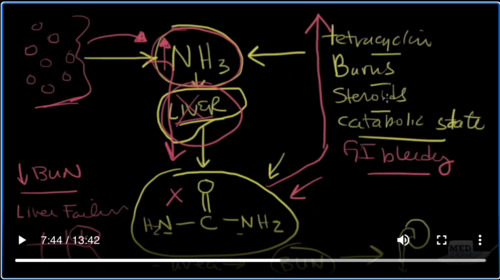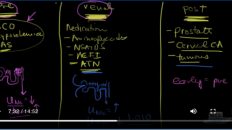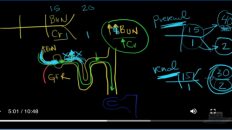急性肾损伤:BUN、肌酐与Nephron (Video 1)
Welcome to another MedCram lecture. We’re going to talk about acute renal failure, and for that we’re going to sort of bring up our Chem 7 again. We talked about this before. You remember you’ll see this a lot. It’s standard. We have sodium. You’ve got potassium. You’ve got chloride. You’ve got the bicarb, and we can talk about the BUN and the creatinine.
欢迎参加另一个MedCram讲座。我们将谈论急性肾衰竭,为此,我们将再次提出Chem 7。我们之前讨论过这一点。您记得您会经常看到这一点。这是标准的。我们有钠。你有钾。你有氯化物。您有碳酸氢盐,我们可以谈谈BUN和肌酐。
So that’s this third column BUN, which should be referred to as the B-U-N; never call it the BUN; it stands for the blood urea nitrogen. Okay, blood urea nitrogen and the Cr is simply creatinine. Okay, so blood urea nitrogen and creatinine. So these things have to do with acute renal failure, but let’s get into a little bit about what they are and where they came from.
这就是第三列BUN,应称为B-U-N;永远不要称其为BUN;它代表血液中的尿素氮。好吧,血液中的尿素氮和Cr只是肌酸酐。好吧,那就是血液中的尿素氮和肌酐。因此,这些事情与急性肾衰竭有关,但让我们对它们的本质和来源有一点了解。
As you know, when you’re talking about energy, you remember something from biochemistry called the Krebs cycle, and it goes around and around and you remember what went into it first? There’s this thing called acetyl CoA. It was basically two carbons. What came out of Krebs cycle? ATP, you had these reducing agents nadh and fadh2. They went into electron transport chain … the electron transport chain, and you got ATP. So basically you need to have two carbon units to get into this Krebs cycle.
如您所知,当您谈论能量时,您会记住生物化学中的一种叫做克雷布斯循环的知识,它不断地在绕来绕去,并且您还记得首先进入其中的是什么?有一种叫做乙酰CoA的东西。基本上是两个碳。克雷布斯周期产生了什么? ATP,您有这些还原剂nadh和fadh2。他们进入了电子传输链……电子传输链,就得到了ATP。因此,基本上,您需要有两个碳单位才能进入此克雷布斯循环。
Well, let’s talk about what are the three different types of energy sources in the body. There are three types. We know that there’s carbs, and carbs are usually six-carbon chains, and six-carbon chains get broken down into 2 X 3 carbon chains and then remember one of these carbons comes off in the form of CO2 during glycolysis. Then you’ve got a two-carbon chain and boom you’re ready to enter the Krebs cycle.
好吧,让我们谈谈人体中三种不同类型的能源。有三种类型。我们知道有碳水化合物,而碳水化合物通常是六个碳链,六个碳链分解为2 X 3碳链,然后记住其中的一个碳在糖酵解过程中以CO2的形式脱落。然后,您已经有了一条由两条碳组成的链,并且您已经准备好进入克雷布斯循环。
The other one is fats or lipids. Okay, you remember that? It had the carboxylic end on it, and you had a bunch of these carbons that went off. It was 16 carbons then it’s promotu CoA. And then remember beta-oxidation, it chops these things up into two-carbon units; you’re able to enter into Krebs cycle.
另一个是脂肪或脂质。好吧,你还记得吗?它上面有一个羧基末端,而您有一堆这样的碳却掉了。这是16个碳,然后是促销性的CoA。然后记住β-氧化,它将这些东西分解成两个碳原子的单元。您可以进入克雷布斯周期。
Well, the last energy group is proteins. Proteins, if you recall, are a collection or a string of amino acids, which have the backbone of N-C-C, many of another N-C-C. Well, we have proteases that are chopping up these proteins. They’re chopping them up into these NCC units. These are amino acids. How do you get these C-Cs into C-Cs? While you basically chop off this N group, and then boom, you’ve got C-Cs going in, and you can make ATP.
好吧,最后一个能量组是蛋白质。如果您还记得的话,蛋白质就是氨基酸的集合或一串氨基酸,它们具有N-C-C和许多N-C-C的主链。好吧,我们有蛋白酶正在切碎这些蛋白质。他们将它们切碎成这些NCC单元。这些是氨基酸。您如何将这些C-C转换为C-C?当您基本上砍掉这N个小组,然后蓬勃发展时,您就有了C-C,您可以制造ATP。
The problem is that there are these Ns that are left behind. So what are these Ns? These Ns are something called ammonia or NH3. Okay, so we got to get rid of these NH 3 groups. Well these NH 3 groups ammonia as what it’s known as. Ammonia is toxic to the body. It’s toxic to the brain. If you have too much of it, it can cause hepatic encephalopathy. So the body’s got to do something about it, somehow to get rid of it. And that’s why we talked about the BUN. okay. So clear the screen here.
问题在于有这些N被遗忘了。那么这些Ns是什么?这些Ns称为氨或NH3。好的,所以我们必须摆脱这些NH 3基团。这些NH 3将氨称为氨。氨对身体有毒。对大脑有毒。如果摄入过多,可能会引起肝性脑病。因此,人体必须对此采取某种措施,以某种方式摆脱它。这就是我们谈论BUN的原因。好的。因此,请清除此处的屏幕。
We’ve got NH3, which is ammonia, and NH3 goes to the liver. Okay, here’s my picture of the liver. So it goes into the liver. And what comes out is something that looks like this: C double bond O; with NH3 or NH2 on one side and an NH2 on the other. This is urea (U-R-E-A). It goes into the blood, and then you get blood urea nitrogen.
我们有NH3,这是氨,NH3进入肝脏。好吧,这是我的肝脏照片。因此它进入肝脏。结果是看起来像这样:C双键O;一侧为NH3或NH2,另一侧为NH2。这是尿素(U-R-E-A)。它进入血液,然后您获得血液中的尿素氮。
So the nitrogen is now compounded; this is not toxic. So this is really nice to have because you can excrete this through the kidney. So again ammonia goes to the liver and then gets made into urea through something called the urea cycle, which we won’t get into. Then you get this BUN; now BUN (blood urea nitrogen) goes to the kidney. Okay, there’s my little picture of the kidney, and it goes out and that’s how you get rid of BUN.
因此,现在氮已经混合了。这是无毒的。因此,这真是太好了,因为您可以通过肾脏排泄它。因此,氨再次进入肝脏,然后通过称为尿素循环的方式变成尿素,我们不会进入。然后你得到这个小玩意现在,BUN(血尿素氮)进入肾脏。好的,这是我的小肾脏图片,它消失了,这就是您摆脱BUN的方式。
So we know how that happens. Let’s talk a little bit about the BUN. Remember the first point is it’s made in the liver. Okay, and there are a couple of things that have absolutely nothing to do with the kidneys that could increase the amount of BUN that you measure in the blood.
因此,我们知道如何发生。让我们来谈谈BUN。请记住,第一点是它是在肝脏中制成的。好的,有些事情与肾脏绝对无关,它们可能增加您在血液中测量的BUN量。
First of all, let’s talk about Burns. So Burns is a catabolic state. What do you think’s going to happen when you have Burns. Burns is going to cause you to have more protein breakdown. As we already know, more protein breakdown is going to give you more ammonia.
首先,让我们谈谈伯恩斯。因此伯恩斯是分解代谢状态。当您BURNS时,您认为会发生什么。BURNS会使您的蛋白质分解更多。众所周知,更多的蛋白质分解将为您提供更多的氨。
All right, what about steroids? Again steroids induce a catabolic state. A catabolic state is going to give you more breakdown of proteins. That’s going to give you more ammonia. The liver is going to make more urea. What about certain antibiotics, tetracycline? Okay. So here are tetracycline, BURNS, steroids, catabolic state. Okay, all of these things can do it.
好吧,类固醇怎么样?再次类固醇诱导分解代谢状态。分解代谢状态将使您分解更多的蛋白质。那会给你更多的氨。肝脏将产生更多的尿素。某些抗生素四环素呢?好的。因此这里是四环素,烧伤,类固醇,分解代谢状态。好的,所有这些事情都可以做到。
Let’s talk about something else. Let’s say you’ve got liver problems. Now in liver problems, or liver failure, or cirrhosis. You can get esophageal varices. Esophageal varices is basic the situation where blood is trying to get back to the heart through the liver. The liver is dysfunctional, and because of that, the blood has to find an alternative route back to the heart. One of those ways is through the esophagus. So these tiny veins which are normally built only to take so much blood becomes engorged, and so these veins can burst and high mortality associated with this.
我们聊点别的吧。假设您有肝脏问题。现在出现肝脏问题,或肝功能衰竭或肝硬化。您可以食管静脉曲张。食管静脉曲张是血液试图通过肝脏回到心脏的基本情况。肝脏功能失调,因此,血液必须找到返回心脏的另一种途径。这些方法之一是通过食道。因此,这些通常只能吸收大量血液的细小静脉会变得充血,因此这些静脉会破裂并因此而导致很高的死亡率。
So you’ve got bleeding. What is bleeding? Bleeding is that (blood gets) into the digestive tract? Well, when that happens, you’ve got these red blood cells. Red blood cells are full of globin. Globin is a protein. You digest down all this protein. Guess what you’re going to get? You’re going to get ammonia. Well, you already have liver failure, so you’re not making this urea, and so what’s going to skyrocket? Your ammonia levels going to skyrocket. That’s why we see in patients with liver failure who have bleeding esophageal bleeding. They get hepatic encephalopathy. And in fact, that’s how you can tell they’re having a paddock encephalopathy.
所以你流血了。什么是出血?出血是(血液进入)消化道吗?好吧,当这种情况发生时,您已经有了这些红细胞。红细胞充满球蛋白。球蛋白是一种蛋白质。您消化所有这些蛋白质。猜猜你会得到什么?你会得到氨。好吧,您已经患有肝功能衰竭,因此您没有生产这种尿素,那么会发生什么?您的氨水平将直线上升。这就是为什么我们在肝衰竭患者中看到食道出血的原因。他们得了肝性脑病。实际上,这就是您可以告诉他们他们患有围场脑病的方法。
Now, let’s say that they have GI bleeding, and it’s not due to liver failure. If their livers are working just fine, you won’t see a buildup of ammonia, but in fact the liver will take that ammonia, and guess what? You’re going to have an increase in BUN, so you can have an increase in your BUN if you have GI bleeding, and your liver is working.
现在,让我们说他们有胃肠道出血,这不是由于肝功能衰竭引起的。如果他们的肝脏运转良好,您不会看到氨的积累,但实际上肝脏会吸收该氨,您猜怎么着?您的BUN将会增加,因此如果GI出血并且肝脏正常,则BUN会增加。
What are some things that could cause your BUN to decrease? So all of these things cause your BUN to go up. What are some things that could cause your BUN to go down? Well, the obvious thing is that your liver is not working. Because if your liver is not working, you’re not going to make BUN: liver failure. I see this all the time; patients come in with liver failure, and I’ll look on the Chem Seven. And their BUN is pretty low, sometimes it’s really even undetectable.
什么会导致您的BUN减少?因此,所有这些都会导致您的BUN上升。有哪些事情可能导致您的BUN掉落?好吧,很明显的事情是您的肝脏无法正常工作。因为如果您的肝脏无法正常工作,您将无法制造BUN:肝功能衰竭。我一直都在看这个;患者因肝功能衰竭而来,我将研究化学七。而且他们的BUN值很低,有时甚至是无法检测到的。
Okay, so we’ve talked about BUN. Let’s review that again. It’s synthesized in the liver. Things that increase, it that has nothing to do with the kidney, would be fever, catabolic State, bleeding tetracyclines, all sorts of things. Things that decrease it would be liver failure because it can’t make the BUN.
好的,我们已经讨论了BUN。让我们再次回顾一下。它是在肝脏中合成的。增加的东西,与肾脏无关,将是发烧,分解代谢状态,四环素出血,各种各样的事情。减少它的事情可能是肝衰竭,因为它不能制造BUN。
Okay, with all those things in mind, let’s talk about what we’re talking about today, which is kidney failure. So I’m going to draw a nephron. Here is my little stylized nephron. Remember the kidney works kind of like you should clean out your closet; you take everything out of the closet, and then you put back just the stuff that you want to keep, and everything else gets thrown away.
好吧,考虑到所有这些事情,让我们谈谈我们今天在谈论的是肾衰竭。所以我要画一个肾单位。这是我的小风格肾单位。记住肾脏的工作方式就像您应该清理壁橱一样。您将所有东西从壁橱中取出,然后只放回想要保留的东西,其他所有东西都被扔掉了。
So here’s the nephron, and here is the blood supply. So you have the afferent arteriole going in, and this is a bunch of capillaries. And what you have is you’ve got flow of fluid into Bowman’s capsule, or the glomerulus, and things go down. Basically, everything that you want to keep gets reabsorbed, and what is left gets dumped out into the toilet.
这是肾单位,这是血液供应。因此,您需要传入小动脉,这是一堆毛细管。而您所拥有的是,您已经有液体流入Bowman的胶囊或肾小球,然后事情就下降了。基本上,您想保留的所有东西都会被重新吸收,剩下的东西会倒入厕所。
Okay, but remember stuff that you want to keep gets reabsorbed, and most of the stuff that gets reabsorbed gets reabsorbed right here at something we call the proximal convoluted tubule (PCT). Probably 70% of the stuff that gets reabsorbed gets reabsorbed here at the proximal convoluted tubule. So about 70% of stuff here in the proximal convoluted tubule gets reabsorbed.
好的,但是请记住,要保留的东西会被重新吸收,并且大多数被吸收的东西在这里被称为我们的近端弯管(PCT)被重新吸收。大约70%的被吸收的东西在这里在近端的曲折小管处被吸收了。因此,近端弯曲小管中约70%的物质被重新吸收。
So really there are two things that you’ve got to be aware of that affect the serum concentration of things in the serum. So if things here are being reabsorbed back into the serum, and those two things are is the GFR (glomerular filtration rate).
因此,确实有两件事需要您注意,这会影响血清中事物的血清浓度。因此,如果这里的物质被重新吸收回血清中,那么这两件事就是GFR(肾小球滤过率)。
What is the rate at which stuff is being filtered into Bowman’s capsule? If you’ve got acute renal failure, this is going to be reduced, and therefore, for instance, if less BUN is being filtered into Bowman’s capsule, you’re going to have an increase in your BUN outside. That goes for just about anything that’s being filtered. The less filtration rate, the greater that accumulation is going to be in the serum because it’s just not being filtered.
东西被过滤到鲍曼胶囊中的速率是多少?如果您患有急性肾功能衰竭,那么这种情况将会减少,因此,例如,如果将更少的BUN过滤到Bowman胶囊中,那么您的BUN就会增加。这几乎适用于所有要过滤的内容。过滤率越低,由于没有被过滤,因此在血清中的积聚就越大。
But there’s an extra added thing here with BUN, and that is that once it gets filtered, if this GFR or this glomerular filtration rate, is low, it’s going to go along here more slowly. If it goes along here more slowly, it’s more likely to be reabsorbed because BUN is specifically reabsorbed here at the proximal convoluted tubule.
但是,BUN在这里还有一个额外的功能,那就是一旦它被过滤,如果这个GFR或这个肾小球滤过率很低,它将在这里进行得更慢。如果它在这里的传播速度较慢,则它很可能会被重新吸收,因为BUN在这里特别是在近端的曲折小管中被重新吸收。
So there are in fact two reasons why the BUN would go up in a low GFR situation. Number one: it’s because it’s not being filtered at the same rate, and the stuff that is being filtered is more likely to be reabsorbed. That’s going to become very important later on.
因此,事实上,在低GFR情况下BUN会上升的原因有两个。第一:这是因为没有以相同的速度进行过滤,被过滤的东西更有可能被重新吸收。稍后这将变得非常重要。
Now. This is in contradistinction to something called creatinine. We talked about creatinine. Creatinine basically comes from muscle, but specifically, creatinine is also filtered here at Bowman’s capsule, but it is not reabsorbed. It just keeps going through and right on out.
现在。这与所谓的肌酸酐相反。我们谈到了肌酸酐。肌酐基本上来自肌肉,但是,肌酐在鲍曼氏囊中也经过过滤,但并未被吸收。它只是不断地进行下去。
In fact, there are areas here where creatinine is actually actively secreted. So what does that mean? That means that if there is a low glomerular filtration rate, that’s a reason why creatinine is going to go up. But it’s not going to have the other reason to go up because it’s not being actively reabsorbed. In fact, it’s being secreted, and so creatinine only goes up for one reason in a low GFR. That’s the major difference between creatinine and the BUN.
实际上,这里有肌酐实际上是活跃分泌的区域。那是什么意思呢?这意味着如果肾小球滤过率低,这就是肌酐上升的原因。但是它不会有其他原因上升,因为它不会被主动吸收。实际上,它是被分泌的,因此肌酐仅在低GFR的情况下会上升,这是一个原因。这是肌酐和BUN之间的主要区别。
let’s talk a little bit about creatinine. What is creatinine?
Okay, creatinine again and the chem 7 is this area down here? And where does it come from? It comes from muscles so muscle breakdown is going to give you creatinine. It’s just a natural byproduct. So the more muscle you have the higher your correct name is going to be normally and the less muscle you have the less you’re creating this going to be and typically you need to see a reduction in your GFR by a least 50% before you see an
In you’re creating. So what are some non renal things that could increase creatinine things that have absolutely nothing to do with the GFR. Well as we talked about remember there are areas here in the nephron specifically where creatinine is secreted. If you could take a inhibitor of that and block it you would block the secretion of creating that would increase your serum concentration of creatinine and there are a couple of drugs that do.
That one of them is called cimetidine.
Tagamet it’s an H2 blocker. And the other one is an antibiotic called trimethoprim.
Okay, so you’ll see an increase in creating for that. What about decreased creatinine? What could cause a decrease in creatinine? We talked about profound muscle-wasting solo muscles. So if you don’t have any muscles that would cause you’re creating to go down and that would be a reason for your crafting to be low. Okay. So to review remember be un is synthesized in the liver. It is both reabsorbed. It is filtered and reabsorbed the
Creatinine is filtered and secreted. It is not reabsorbed. So if there is a Slowdown in filtration The Bu n is going to be increased because of lack of filtration and also because reabsorption the creatinine is only going to be increased because of lack of filtration. Therefore, you’re going to see a larger be un increase then you would create an in in the low Flow State. Alright that does it for part 1 join me for part 2




Add comment